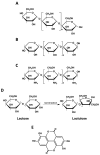The Role of Prebiotics in Modulating Gut Microbiota: Implications for Human Health
- PMID: 38732060
- PMCID: PMC11084426
- DOI: 10.3390/ijms25094834
The Role of Prebiotics in Modulating Gut Microbiota: Implications for Human Health
Abstract
The human gut microbiota, an intricate ecosystem within the gastrointestinal tract, plays a pivotal role in health and disease. Prebiotics, non-digestible food ingredients that beneficially affect the host by selectively stimulating the growth and/or activity of beneficial microorganisms, have emerged as a key modulator of this complex microbial community. This review article explores the evolution of the prebiotic concept, delineates various types of prebiotics, including fructans, galactooligosaccharides, xylooligosaccharides, chitooligosaccharides, lactulose, resistant starch, and polyphenols, and elucidates their impact on the gut microbiota composition. We delve into the mechanisms through which prebiotics exert their effects, particularly focusing on producing short-chain fatty acids and modulating the gut microbiota towards a health-promoting composition. The implications of prebiotics on human health are extensively reviewed, focusing on conditions such as obesity, inflammatory bowel disease, immune function, and mental health. The review further discusses the emerging concept of synbiotics-combinations of prebiotics and probiotics that synergistically enhance gut health-and highlights the market potential of prebiotics in response to a growing demand for functional foods. By consolidating current knowledge and identifying areas for future research, this review aims to enhance understanding of prebiotics' role in health and disease, underscoring their importance in maintaining a healthy gut microbiome and overall well-being.
Keywords: human health; intestinal microbiota; microbiota; prebiotics.
Conflict of interest statement
The authors declare no conflicts of interest.
Figures





References
Publication types
MeSH terms
Substances
Grants and funding
LinkOut - more resources
Full Text Sources

